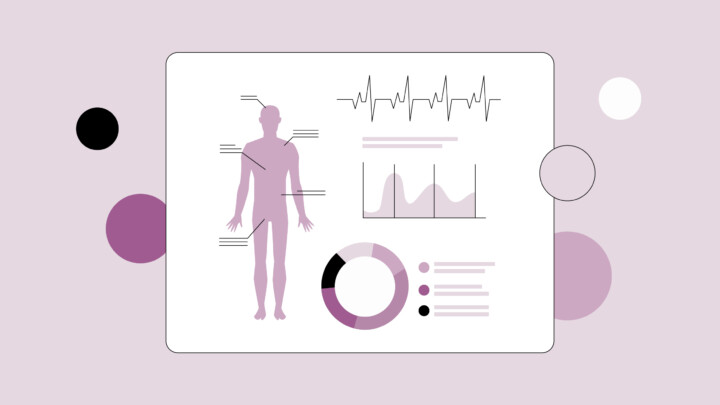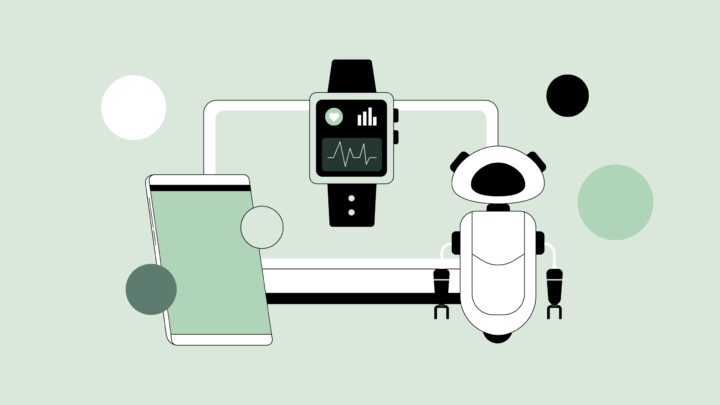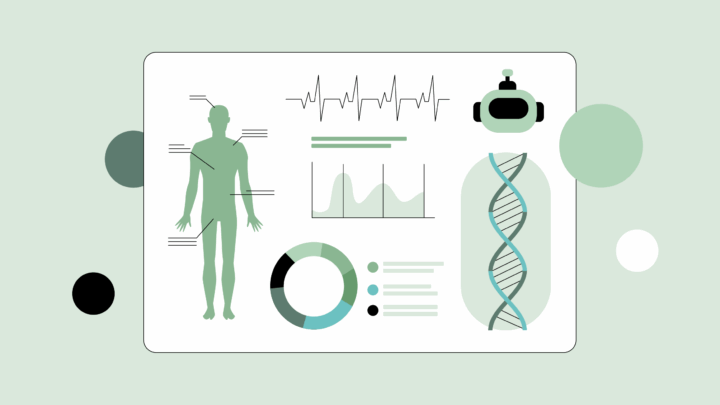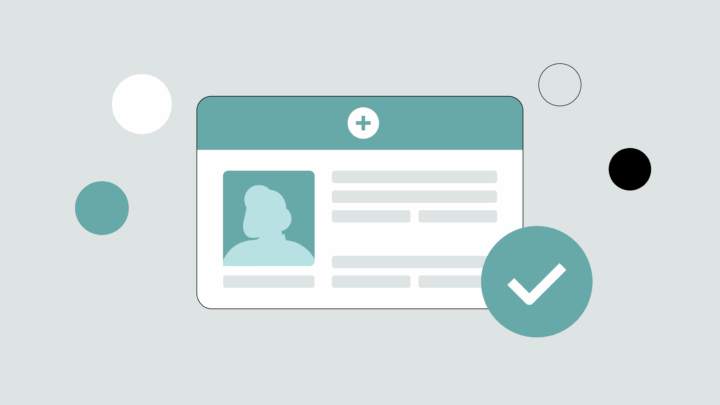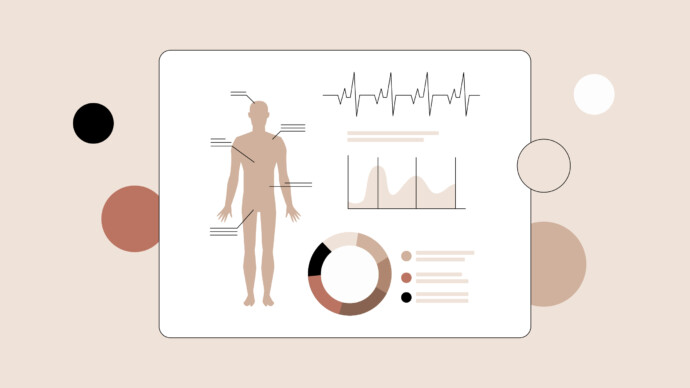
Implementing an electronic health record (EHR) system doesn’t just change how a practice manages files; it reshapes how physicians diagnose, document, and communicate. From patient intake to follow-up, EHRs directly impact clinical workflows, diagnostic decisions, and your time with patients.
EHR implementation refers to the process of transitioning from traditional paper-based medical records to a fully integrated, electronic system for managing patient data. For private practices, EHR implementation is a foundational shift impacting workflows, patient relationships, and daily operations. A well-designed EHR implementation plan can streamline administrative tasks, improve patient care, and enhance the overall efficiency of your practice.
However, the process is not without its challenges. A Sermo poll shows that 65% of physicians believe EHRs lead to better patient outcomes, while 35% are less convinced about their efficacy. Physicians voice a range of opinions on EHR systems, from their frustrations about steep learning curves and increased admin to appreciation for how EHRs centralize data for better decision-making. As a U.S. psychiatrist and Sermo member highlights their frustration, “Long work hours have been made worse by those who mandated the Electronic Health Record, which converted physicians into data entry workers. Other problems with EHRs are eye strain/headaches, gigantic start-up and ongoing yearly costs.”
On the other hand, a physiatrist from Venezuela writes, “It allows easy access anywhere and a better collection of data about everything if the patient suffers from a pathology that requires review and management by various specialties.”
This guide provides a detailed roadmap to transition to a new electronic health records system, tackle challenges in the process, and maximize benefits for physicians and your patients.
Transitioning from paper charts to an EHR
Moving from paper charts to an EHR system or upgrading to a new EHR is a significant step in modernizing a practice and improving health information management.
A GP on Sermo summarizes it well, saying, “Implementing an EHR is a complex but necessary step for improving healthcare. In Mexico, current issues include lost records due to disorganization, leading to delayed information and inappropriate treatments. Additionally, establishing an EHR presents challenges such as ensuring robust data security and confidentiality, which is currently lacking.”
Before decision-makers clear out those patient filing cabinets, a structured implementation plan is essential for a smooth transition to an EHR system.
Make a transition plan
EHR leaders must begin by defining their organization’s goals for implementing an electronic health record system. Is the goal to streamline scheduling? Improved communication with specialists? Enhanced billing accuracy? A clear transition plan helps set timelines, allocate resources, and prepare for potential disruptions in daily operations for your record system. It takes a minimum of 60 to 120 days to transition to a new EHR system, and large-scale transitions can even take years to get right.
For those not leading the change, make sure you’re aligned with the goals and transition plan set out by your organization, so that you know what to expect.
Communicate the plan to staff
Healthcare stakeholders leading the change must build an EHR timeline, and goals should be clearly communicated to all staff, including nurses and doctors. Hold introduction and follow-up meetings to share your vision for the EHR system and how it will benefit both staff and patients.
EHR transitions require a project manager to keep tasks on track and stakeholders accountable. While IT developers and analysts handle the technical setup, department-led advocates play a critical role in ensuring that the system aligns with real clinical workflows.
Physicians not directly involved in implementation can consider becoming a super user to get a leg up on learning the new system and be the first to provide feedback. Super-users are early adopters who are the first to test the new system as it is deployed and your input helps shape templates, shortcut protocols, and documentation tools that affect daily care delivery. Open lines of communication encourage feedback and foster adoption, reducing user resistance to change.
Decide what data needs to digitize
Not every piece of information in a practice’s paper records needs to be digitized. Most healthcare information exchange (HIE) systems, like EHRs, will house these types of medical history:
- Chronic conditions
- Current medications
- Laboratory orders
- Clinical results
- Immunizations
- Syndromic surveillance
- Public health data
- Progress notes and documentation (like transcripts, care summary notes, EMT/1st responder notes, etc.)
- Patient referrals
- Electronic prescribing and refill information
- Discharge summaries
Project directors must focus early efforts on prioritizing essential patient data for the electronic health record implementation. In the U.S., HIPAA requires medical record archives for a minimum of six years from the last treatment date; workers’ compensation records must be kept even longer. Records can be stored on-site or off-site, taking into account staff accessibility and security requirements. These steps are key to maintaining patient privacy.
Map out workflows at your practice
EHR system managers must understand how patient intake, billing, and follow-ups operate in the healthcare organization’s current process, then plan how they’ll be laid out in the EHR. Most EHRs allow for customization to make sure the system aligns with specific practice needs, optimizing efficiency and clinical decision support, so it’s key that each department clearly lays out how their standards of procedures need to be mapped out in the EHR.
Train staff to use the EHR tool
Physicians and administrative staff alike need a few weeks to learn system navigation, data entry protocols, and troubleshooting techniques for the EHR software. Leverage vendor-provided training sessions to ensure your team feels confident and capable, then hold practice runs to gauge aptitude. Proper training is vital for successful team adoption, ensuring that physicians are well-equipped to use the new system and preventing scenarios in which a physician spends time during a patient consultation fumbling through the system, instead of focusing on the patient’s needs and building rapport.
Decide what to do with paper records
For records that will not be digitized and need to remain in hard copy format (e.g., legal documents), EHR leaders must establish a streamlined filing system. Consider scanning older, infrequently accessed records into an archive, reducing physical storage while increasing accessibility when needed. Create a standard of procedure (SOP) document outlining when staff should destroy paper files.

The 5 stages of EHR implementation
Implementing an EHR system follows predictable stages, each presenting unique challenges and opportunities. Here’s what to expect in a typical EHR implementation process:
Stage 1: Planning and preparation
Healthcare organizations, such as large hospitals and health systems, can expect to pay an average of $1,200 per user per year for EHR systems. However, small independently owned practices often face significantly higher per-user costs, making EHR adoption more financially challenging for them. Larger practices may also benefit from economies of scale, which reduces their cost per user as compared to smaller organizations. Beyond software licensing costs and hardware upgrades, other EHR costs you should plan on include new security tools, data storage and backup, interoperability costs, implementation services, staff training, and annual license renewal fees.
In terms of timing, deployment can take 2 to 4 months, with much longer needed for large hospital transitions. In this example, Trinity Health took years of planning and 18 months of co-ordination for an EHR transition to take place.
Start by conducting a needs assessment. Outline your practice’s requirements, research EHR systems and tools, and define a budget. This stage is critical for setting realistic goals and timelines for your health information systems. A good implementation strategy considers scalability and compliance with privacy regulations, like HIPAA.
Stage 2: System selection and customization
The timeframe for reviewing and selecting an EHR is typically 12 weeks for most organizations, with the timeframe nearly twice as long for large clinics or bed hospitals. Selecting the right EHR software is more than choosing features—it’s about finding a system that aligns with your practice’s workflows and offers strong functionality.
When selecting an EHR vendor, prioritize those that specialize in your market. Niche-specific programs offer more relevant features than generic ones, reducing customization needs and developer costs. Once chosen, work with the vendor to customize templates, user interfaces, and reporting dashboards to suit your specific practice needs, optimizing for patient care and patient safety.
Looking for help choosing a practice management software? See our full guide here.
Stage 3: Data migration and preparation
Ensure a seamless transition by thoroughly preparing legacy data (a.k.a patient health information that was collected and stored in the previous system). Develop protocols for securely migrating critical patient information into the new system, while maintaining its accuracy.
Key stages of EHR data migration:
- Identify essential data
Focus on high-priority clinical records: diagnoses, labs, imaging, medications, allergies, and visit notes. - Clean and verify data
Ensure accuracy, remove duplicates, and correct outdated entries before transferring. - Map data fields
Align old records with the format and fields of your new EHR system. - Transfer and test
Import the cleaned data and verify that it displays correctly in the new system. - Validate with clinical users
Physicians and staff should review a sample of migrated data to catch errors and confirm usability.
If you’re feeling overwhelmed, hire an IT specialist to prevent data loss or set-up headaches during this crucial phase.
Stage 4: Training and user adoption
Lack of training is a commonly cited reason why healthcare professionals feel overwhelmed by new EHR systems. Role-based training ensures that administrative staff, physicians, and medical assistants all understand how the system fits their functions. Plan to hold front-loaded training meetings and then conduct quarterly check-ins to review updates and new use cases. By having clear training and documentation in place, it boosts team buy-in and reduces resistance.
Before going live, you should have a clear roadmap of the process.
- System testing procedures (pre- and post-implementation)
- Patient communication guidelines (including anticipated downtime)
- Staff scheduling, including necessary overtime or temporary personnel
- Appointment and scheduling adjustments
- Reporting procedures for system and project assessment (refer to step 8)
- In-practice communication strategies (e.g., noticeboard announcements)
- Network speed and reliability verification
- Data backup protocols
Stage 5: Go-live and post-implementation
The go-live phase is when the transition to your chosen EHR is official. Dedicated technical support channels must be in place to address challenges promptly. Post-implementation monitoring helps you optimize the system, tracking its effectiveness and gathering feedback from users.
Here’s how to monitor your EHR implementation effectiveness:
- Patient Throughput: Record the number of patients seen to assess the system’s efficiency.
- Patient Satisfaction: Survey patients to gauge their satisfaction with the quality of care received.
- Physician Satisfaction: Survey physicians to evaluate their adoption of the system and the effectiveness of training.
- Data Error Rates: Analyze error rates in data input to determine the quality and accuracy of the data.
- Evaluate staff productivity: Observe changes in administrative task completion times and overall workflow efficiency.
- Monitor patient engagement: Assess metrics like appointment adherence, portal usage, and patient feedback on digital interactions.
- Track ongoing costs: Measure training, annual renewal, and technical costs of sustaining the EHR.
- Track financial performance: Analyze billing cycles, claim denials, and overall revenue growth to identify financial return compared to implementation costs.
Key benefits of implementing an EHR system as a physician
The overall adoption of an electronic health record system offers significant benefits for physicians and patient care.
In a recent Sermo survey, we asked physicians, “Have you seen specific instances where EHRs have helped?” Having all necessary health information, such as lab results, in one place accounts for 37% of physician votes, while resolving conflicts in prescribed medication accounts for 23%. Necessary information being available even when a patient is unconscious accounts for 20%, and 17% of physicians said their EHR helped with a diagnosis.
Below are several key benefits:
Optimized practice workflows
EHRs streamline medical practice management by automating tasks such as patient registration, scheduling, coding, billing, and claims management. This cuts time and resources spent on manual paperwork, transcription, and chart handling. Ultimately, the EHR system could free up physician time to focus on patient outcomes by reducing bottlenecks.
Improved patient care and retention
The functionality of a robust EHR software significantly impacts patient care. Access to centralized, up-to-date patient records enables informed and accurate diagnoses, for example, by identifying potential medication interactions, abnormal lab trends, or overdue screenings, enhancing patient trust and outcomes.
As a GP writes on Sermo, “The electronic recording of patient data is beneficial for the patient and the doctor because when a patient consults, the patient’s record is quickly viewed and previous health information about the patient is already known, which must always be known when he attends the consultation. This is crucial for med care.”
Having this clinical data on hand helps with more relevant referrals and care coordination, further boosting patient satisfaction and retention rates.
Saved time with streamlined patient data management
EHRs consolidate data and present it in more actionable formats, which may save physicians valuable time that would otherwise be spent sifting through notes. To this point, a pediatrician on Sermo highlights the importance of health information systems: “It really is a good tool because it keeps the patient’s data and history in an organized way.”
Numerous EHR benefits have been reported, including improved communication and information exchange, as well as reduced errors among medical staff. Staff also mentioned the improved legibility of notes, increased access, the use of templates, and enhanced communication and speed. The result? Faster consultations and reduced time spent on redundant symptom analysis or treatment diagnosis.
Reduced maintenance and operation costs
Hospitals with electronic health record (EHR) systems benefit from reduced operating costs, particularly when EHR functionality is comprehensive. A study analyzing data from 1,596 U.S. hospitals between 2016 and 2019 found that increasing levels of EHR functionality were associated with significant reductions in hospital operating costs, specifically in urban hospitals. The cost savings were about 0.14% for each additional EHR function implemented, with reductions driven mainly by decreases in general/ancillary and outpatient costs. The study suggests that the operational efficiencies introduced by advanced EHR capabilities—such as improved clinical documentation and decision support—help lower expenses, although this effect was not observed in rural hospitals
An integrated digital system also eliminates the need for expensive physical storage facilities and paper forms, cutting costs over time. This is a significant advantage for large private practices and healthcare organizations.
Increased revenue
EHR implementation can speed up workflows, improve billing accuracy, streamline claims, and accelerate reimbursements through automation. Many practices report increased revenue—not from more patient visits, but from better documentation, improved charge capture, and higher billing for ancillary services. By reducing errors and inefficiencies, EHRs help prevent revenue leakage and support more sustainable practice growth..
Reduced staff workload
Overall, 58% of surveyed physicians say EHRs have had a positive effect on their work-life balance. Automated routines and optimized workflows lower the administrative burden on staff, reducing the amount of time needed for coding, billing and charting.

Potential challenges and mitigation strategies
A cross-study of EHR system implementations reveals a range of challenges faced by physicians, staff, and organizations as a whole. Here’s how to address the most common roadblocks for healthcare providers:
Technical capabilities
Outdated hardware or a lack of IT expertise can disrupt EHR rollouts. A neurologist highlights challenges in implementing an EHR on Sermo, saying, “Every time they update to fix one bug, the update ends up creating two more. Doesn’t help that our desktops are ancient.”
Mitigation strategies include investing in modern hardware tech and contracting external IT support. A psychiatrist explains on Sermo, “The IT experts stressed the need for redundant equipment and connectivity; disaster recovery plans and downtime procedures; appropriate system security; appropriate system monitoring to detect failures or misuse; and backup solutions such as standalone computers and paper documentation. The above parameters would provide a contingency plan to avoid and manage EHR failures.” This is crucial for information systems in hospitals and makes the overall EHR system more accessible.
EHR implementation costs
The EHR implementation plan must account for significant upfront costs. According to OmniMD, for small practices the average up-front implementation costs range from $20,000 to $65,000. Mid-sized clinics typically see up-front costs between $65,000 and $200,000. Large hospitals or enterprise-level systems typically face initial costs ranging from $200,000 to $650,000, and in some cases, multi-million-dollar budgets are reported for major systems like Epic.
This isn’t even taking into account ongoing management costs. However, long-term savings in operational costs and increased customer volume do offset initial costs. Leverage industry-specific financing options to ease the financial burden.
User resistance
U.K. researchers have identified a decline in staff morale and clinician burnout as potential consequences. While the precise mechanism linking EHR to burnout remains unclear, contributing factors cited include an increased documentation burden, greater time commitments, difficulties with usability, and general fatigue. This is a significant concern for the adoption of EHR.
70% of surveyed physicians have experienced excessive EHR screen time leading to fatigue or burnout. However, resistance to EHR implementation often arises from a fear of change. Achieving meaningful use of the EHR system requires user buy-in and encouraging input from stakeholders and customizing systems ensures relevance, softening resistance.
Workflow disruption
Transitioning is inevitably disruptive, and it can be time-consuming for physicians or staff to adapt.
As an ophthalmologist and Sermo member comments, “We have truly created a modern-day Frankenstein with the majority of physicians shackled to a desktop, laptop, or iPad trying to use systems that cannot do what we do as doctors. The current state of EHR is woefully inadequate. It does make the notes look better, improves legibility, places a great deal of unnecessary information into the medical record, and meets government and insurance company mandates. That being said, I think there is great potential for this to be a useful tool for docs, but we need to tell IT what we need, not the converse. I use several different EHR’s and I would give them a “C” rating at best. They are cumbersome, temperamental, and time-consuming.”
Planning gradual rollouts and assigning key stakeholders for each phase of deployment (as listed above) minimizes downtime and ensures smoother operations during go-live stages. Once live, establishing feedback loops and SOPs around usage is key to onboarding new users and minimizing current user fatigue.
Training needs
Approximately 80% of medical staff in the Oral and Maxillofacial Department in this hospital reported they did not receive sufficient training for their EHR implementation. Address training gaps by scheduling short, frequent role-based sessions and gathering user feedback during each phase of deployment. EHR companies typically offer learning portals and resources tailored to your system. For more advanced training, consider hiring EHR training consultants.
Privacy concerns
Privacy and security are key concerns for any health information system. EHR failures can lead to data breaches or prevent access to patient information during natural disasters or power outages if not properly backed up and maintained.
Before implementing EHRs, seek clarity on the privacy safeguards and protocols integrated into your new system to address these concerns effectively. Follow protocols such as HIPAA guidelines, encrypted systems, and multi-factor authentication to safeguard patient data.
Conclusion
EHR implementation is undoubtedly complex, but successful adoption can transform a private practice into a more efficient, patient-centered organization. Key steps like planning, training, and monitoring can mitigate challenges, ensuring that your practice reaps the full benefits of transitioning to electronic records. For physicians, your clinical voice is essential in shaping templates, training workflows and optimizing the user experience. Early engagement can reduce friction and increase adoption success.
Looking for tips, advice, or even cautionary tales? Join Sermo’s community of over 1.5 million healthcare professionals. Connect with peers, discuss EHR systems, and discover firsthand accounts of what works—and what doesn’t. Take control of your EHR implementation with insights from physicians who’ve been there.
Key Takeaways
- Implementing an EHR system isn’t a plug-and-play process; it’s a comprehensive, step-by-step transformation. Each stage (from planning and vendor selection to training and post-launch optimization) requires thoughtful planning and deep organizational coordination. Skipping steps or underinvesting in user engagement can lead to long-term dysfunction or system failure.
- While EHR systems promise streamlined data management, improved patient care, and reduced administrative burden, many physicians report that current systems fall short. Pain points include poor usability, increased screen time, costly maintenance, and unintuitive interfaces. A successful EHR must be designed around clinical needs, not bureaucratic checklists.
- Small, mid-sized, and large practices each have distinct EHR needs. Customization, integration, training, scalability, and support infrastructure are critical in choosing the right vendor. Reviews of top tools for each segment help guide practices in selecting a system that truly fits their size and scope.
- Whether leading the change or advising on integration, physicians can benefit from having basic knowledge on the steps of implementation and the common issues to look out for.
